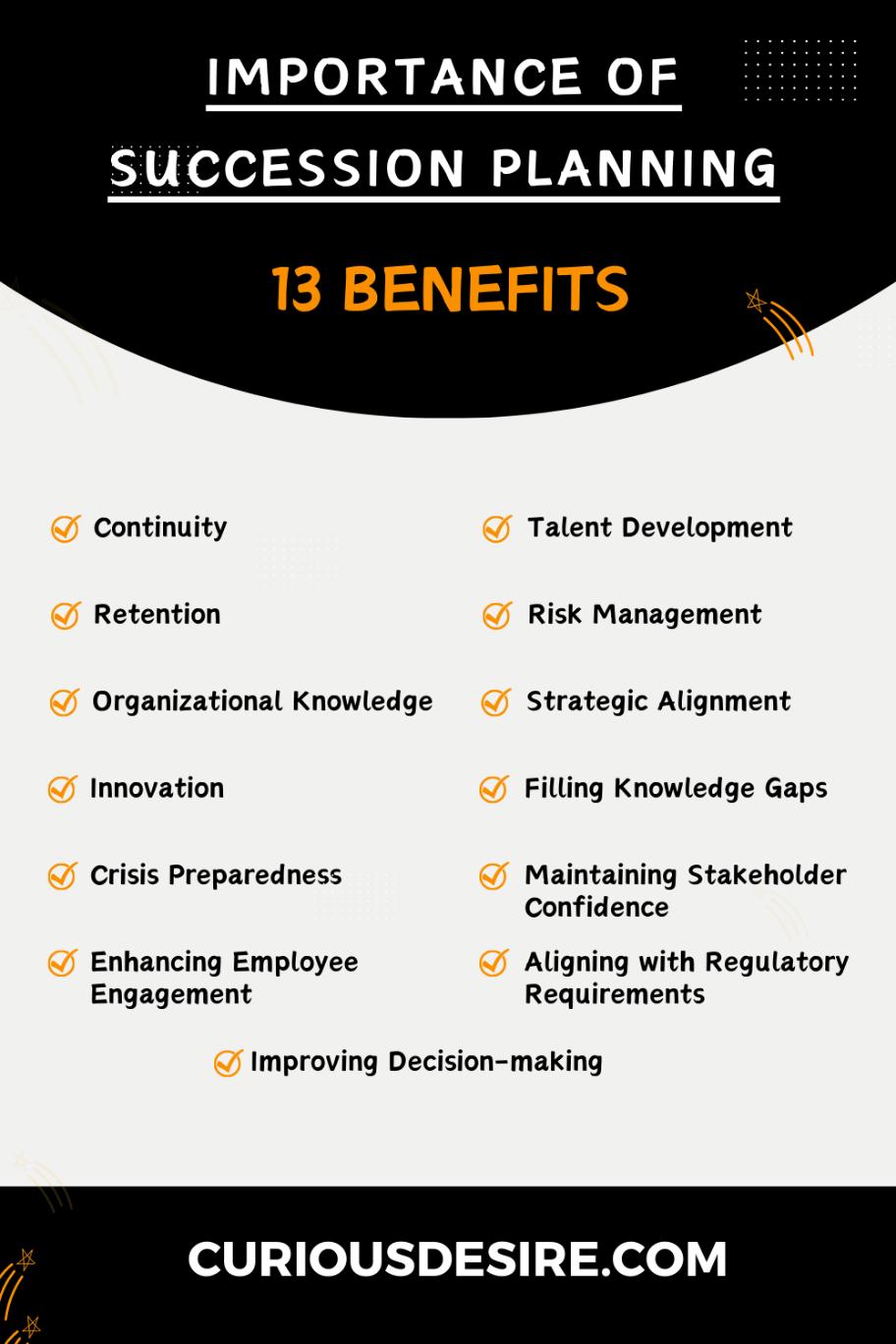Succession planning is an essential aspect of organizational strategy, ensuring smooth transitions in leadership roles.
It involves identifying and developing internal talent to fill key positions as they become vacant.
In this discussion, we will highlight the importance of succession planning, highlighting its benefits for implementation in contemporary business environments.
[toc]

1. Continuity
Succession planning ensures a smooth handover to new leadership when key individuals depart the organization due to retirement, promotion, or unforeseen circumstances.
This prevents disruptions in day-to-day operations and helps maintain stability within the organization.
2. Talent Development
Succession planning is not just about filling current vacancies; it’s about investing in the future of the organization by identifying and grooming high-potential employees for leadership roles.
This promotes a culture of continuous learning and growth, as employees are given opportunities to develop their skills and take on new challenges.
By providing clear pathways for advancement, succession planning boosts employee morale and engagement, leading to higher retention rates and a more motivated workforce.
3. Retention
Employees are more likely to stay with an organization that values their development and offers opportunities for career progression.
Succession planning sends a strong message to employees that their contributions are recognized and that there are opportunities for advancement within the organization.
This helps improve employee satisfaction and loyalty, reducing turnover and the associated costs of recruitment and training.
4. Risk Management
Without a succession plan in place, organizations are vulnerable to disruptions caused by sudden departures or changes in leadership.
Succession planning helps mitigate these risks by identifying potential successors and ensuring they are prepared to step into key roles when needed.
By having backup plans in place, the organization can maintain continuity and minimize the impact of unexpected events on its operations and performance.
5. Maintaining Organizational Knowledge
Key employees often possess valuable knowledge and expertise that is critical to the organization’s success.
Succession planning helps transfer this knowledge to successors, ensuring that important institutional knowledge is retained and passed down.
By documenting processes and best practices, the organization can ensure that it remains competitive and resilient, even as key individuals retire or move on to other opportunities.
6. Strategic Alignment
Succession planning allows organizations to align leadership development efforts with strategic goals and objectives.
By identifying the skills and competencies needed for future success, organizations can ensure that their leadership pipeline is equipped to drive strategic initiatives forward.
This ensures that the organization has the leadership capabilities it needs to adapt to changing market conditions and seize new opportunities.
7. Adaptability and Innovation
Succession planning helps organizations remain agile and innovative by ensuring that leadership teams are diverse, inclusive, and representative of different perspectives.
By cultivating a diverse pool of talent, organizations can better adapt to change and capitalize on new opportunities.
This provides a culture of innovation where new ideas are encouraged and embraced, driving the organization’s long-term success and competitiveness.
8. Mitigating Knowledge Gaps
Succession planning helps identify potential gaps in knowledge or skills within the organization.
By proactively addressing these gaps through training, mentoring, or recruitment, organizations can ensure that critical areas of expertise are not overlooked or neglected.
This helps maintain the organization’s competitive edge and ensures that it remains responsive to changing market dynamics and customer needs.
9. Crisis Preparedness
Succession planning is crucial for ensuring that organizations can maintain stability and continuity during times of crisis or emergency.
By having a well-defined succession plan in place, organizations can quickly mobilize alternative leadership arrangements and ensure that key functions continue to operate smoothly, even in the face of unforeseen challenges.
This builds resilience and helps safeguard the organization’s reputation and long-term viability.

10. Maintaining Stakeholder Confidence
Stakeholders, including investors, customers, and partners, rely on stable and effective leadership to maintain confidence in the organization.
Succession planning demonstrates to stakeholders that the organization is prepared for leadership transitions and committed to long-term sustainability.
This helps maintain trust and credibility, which are essential for building strong relationships and securing support from key stakeholders.
11. Enhancing Employee Engagement
Succession planning catalyzes employee engagement by providing clear pathways for career advancement and growth.
When employees see opportunities for development and progression within the organization, they are more motivated to invest their time and effort into their work.
By offering training, mentorship, and advancement opportunities, organizations demonstrate their commitment to supporting employee growth and success.
12. Aligning with Regulatory Requirements
Succession planning ensures that organizations comply with regulatory requirements by having processes in place to identify and develop future leaders.
Regulatory bodies often require organizations to have succession plans as part of good governance practices to mitigate risks associated with leadership transitions.
By adhering to these requirements, organizations demonstrate their commitment to accountability and transparency.
Having a succession plan not only helps organizations avoid potential fines or penalties but also instills confidence in stakeholders that the organization is well-prepared to navigate leadership changes effectively and responsibly.
13. Improving Succession Decision-making
Succession planning involves strategic decision-making based on objective evaluation and analysis of potential successors.
Instead of relying on intuition or subjective judgments, organizations assess candidates’ skills, experience, and performance to make informed decisions about leadership appointments.
This approach minimizes biases and ensures that the most qualified individuals are selected for key roles.
By establishing clear criteria and processes for succession decision-making, organizations enhance the likelihood of successful leadership transitions and long-term organizational stability.
Importance of Succession Planning – FAQs
1. What is the importance of succession planning?
Succession planning is vital for ensuring the continuity and sustainability of an organization.
It allows businesses to identify and develop internal talent to fill key leadership positions when they become vacant due to retirements, promotions, or unforeseen circumstances.
By proactively preparing for leadership transitions, organizations can minimize disruptions, maintain operational stability, preserve institutional knowledge, and foster a pipeline of capable leaders to drive future success.
2. Why is succession planning important in corporate governance?
Succession planning plays a crucial role in corporate governance by providing a structured framework for identifying and developing talent within the organization.
It ensures that there is a clear plan in place for replacing key executives and leaders, reducing the risk of disruptions to business operations or loss of momentum in strategic initiatives.
Additionally, effective succession planning enhances transparency, accountability, and strategic alignment within the organization, ultimately contributing to improved corporate governance practices.
3. What are the needs for succession planning?
The needs for succession planning include:
- Identifying key leadership positions within the organization.
- Assessing current and potential future talent to fill these positions.
- Developing a pool of internal candidates through training, mentoring, and skill development programs.
- Creating a structured succession plan outlining the process for identifying, evaluating, and transitioning new leaders.
- Establishing clear criteria and metrics for measuring the success of the succession planning process.
- Ensuring buy-in and support from senior leadership and key stakeholders.
- Regularly reviewing and updating the succession plan to adapt to changing business needs and talent dynamics.
4. What are the five critical steps of a succession plan?
The five critical steps of a succession plan typically include:
- Identifying Key Positions: Determine which leadership roles are critical to the organization’s success and require succession planning.
- Assessing Talent: Evaluate the current talent pool to identify potential successors for key positions. This may involve performance assessments, competency evaluations, and development planning.
- Developing Talent: Implement development initiatives to groom high-potential employees for future leadership roles. This could include training, mentoring, stretch assignments, and leadership development programs.
- Creating a Succession Plan: Develop a structured succession plan outlining the process for identifying, assessing, and transitioning successors into key roles. Define timelines, responsibilities, and contingency plans for various scenarios.
- Monitoring and Evaluation: Regularly review and assess the effectiveness of the succession plan. Monitor the progress of identified successors, adjust development plans as needed, and address any gaps or challenges that arise.
5. How many steps are needed in the succession planning framework?
The number of steps in a succession planning framework may vary depending on the organization’s size, complexity, and specific needs.
However, a comprehensive succession planning framework typically includes several key steps, such as identifying key positions, assessing talent, developing successors, creating a succession plan, implementing the plan, and monitoring and evaluating its effectiveness.
Each step is essential for ensuring a systematic and proactive approach to succession planning that aligns with the organization’s strategic objectives and fosters long-term success.
